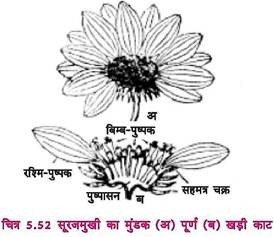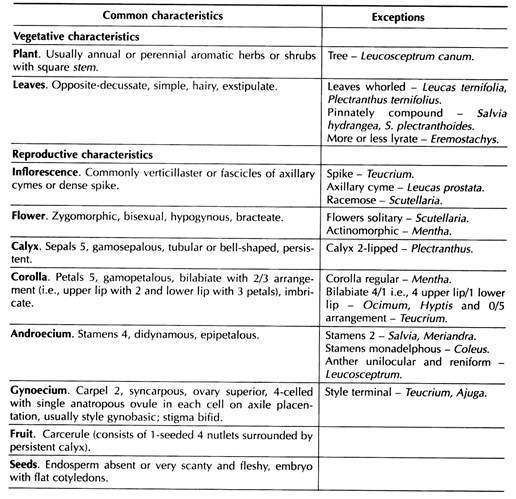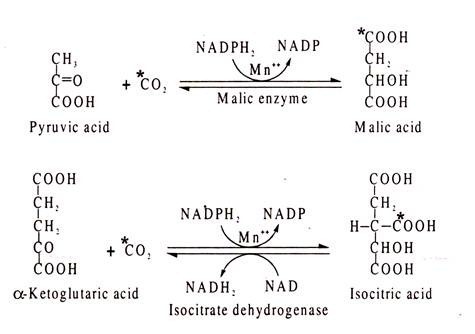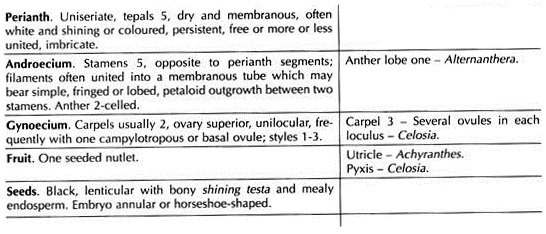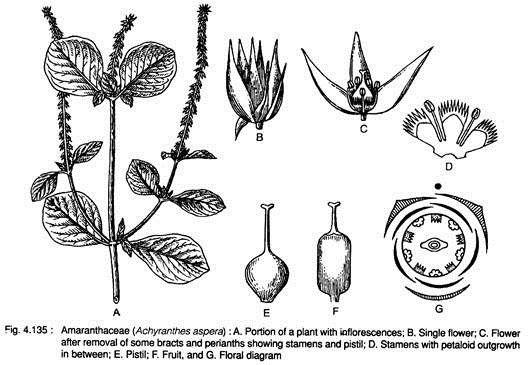Read this essay you will learn about:- 1. Labiatae (Lamiaceae) 2. Amaranthaceae (Amaranthus Family).
Essay # 1. Labiatae (Lamiaceae):
(Mint Family)
The family Labiatae consists of 264 genera and 6,990 species and is found to grow almost throughout the world and especially in the Mediteranean region. About 64 genera and 380 species are distributed in India at different habitat mainly in North West and Southern part of India.
The type genus of the family is Lamium.
Systematic Position:
Labiatae: Distinctive Features:
Identifying Characteristics:
1. Plants are aromatic herbs or shrubs.
2. Stem square and covered with glandular hairs.
3. Leaves simple, exstipulate, arranged in opposite-decussate phyllotaxy.
4. Inflorescence — Verticillaster.
5. Flowers bisexual, zygomorphic.
6. Corolla bilabiate.
7. Stamens 4, didynamous, epipetalous.
8. Carpels 2, syncarpous, 2-chambered (which ultimately become 4-chambered). Placen tation axile. Style gynobasic .
9. Fruit- one seeded 4 nutlets (cacerule).
Floral Formula:
Phylogeny and Systematic:
The family is very closely related with Verbenaceae. It resembles Boraginaceae in fruit characteristics but is distinguished them sharply by the position of radicle.
Bentham and Hooker placed the natural order Labiatae under the cohort Lamiales, series Bicarpellatae, sub-class Gamopetalae and class Dicotyledons.
Engler and Prantl placed the family under the order Tubiflorae, sub-class Metachlamydeae under the class Dicotyledoneae.
Hutchinson, Takhtajan and Cronquist placed the family under the order Lamiales. Hutchinson placed the order Lamiales under the division Herbaceae. Takhtajan and Cronquist placed the order Lamiales in subclass Asteridae under the class Magnoliopsida.
Common Plants:
1. Anisomeles indica (L.) O. Kuntz. (Syn. A. ovata R. Br.);
2. Hyptis suaveolens Poir.;
3. Leonotis nepetifolia (L.) R. Br.;
4. Leonurus sibiricus L.;
5. Leucas aspera Spreng. (Syn. L. mollisima Wall.);
6. L. procumbens Desf.;
7. Ocimum sanctum L.;
8. Pogostemon plectranthoides Desf.;
9. Salvia splendens Ker-Gawl. (Syn. S. colorans hort. ex Benth.)
Key to Genera:
I. Stamens 4 perfect, rarely 2; anther-cells 2, confluent; ovary 4-partite; dry nutlets with basal scars:
1. Lower corolla-lip flat
Calyx segments deflexed in fruit; upper lip large, decurrent; stigma bifid; racemes bearing whorls of 6-10 flowers; hers or shrubs……………………… Ocimum.
2. Lower corolla-lip concave, boat-shaped
ii. Calyx-segments 5, equal or rarely toothed; filaments free … Plectranthus.
iii. Calyx 5, always 2-lipped; stamens 4; filaments connate below; herbs or shrubs with fleshy stem and leaves ………………………. Coleus.
3. Corolla obscurely 2-lipped with 2 upper lobes flat, similar and subequal to two laterals, all about as long as the abruptly deflexed, saccate lower lip; cajyx teeth subequal………………. Hyptis.
II. Stamens 4, upper pair long; anthers 1- or 2- celled; corolla flat:
i. Calyx 5-toothed, ovoid; core sub- equally 4-lobed; stamens exserted; filaments bearded; small plants with whorled leaves and densely spicate flowers…………… Dysophylla.
ii. Calyx 5-toothed; lower corolla-lobe subpatent; stamens exserted; whorls in glomerate or panicular spike; filament bearded or naked ………………… Pogostemon.
iii. Calyx 5-partite, plumose segments; stamens included; fruit-nutlets ovoid; hairy plants, usually hoary shrubs, with opposite crenulate leaves ………………….. Colebrookia.
iv. Calyx 5-toothed, often enlarged and inflated in fruits; corolla tubular, incurved or straight; stamens diverging with divaricate anther-cells; plants herbs or undershrubs with opposite leaves ……………….. Elsholtzia.
III. Stamens 4, perfect, lower pair longest; calyx 5-10-nerved; upper lip of corolla hooded, villous; anther-cells 2, diverging:
i. Upper corolla-lip short, flat, pubescent; anther-cells of upper pair dimidiate and those of lower ones parallel; tall coarse herbs … Anisomeles.
ii. Upper corolla-lip hooded, purple, villous; calyx 5, spinous; anther-cells parallel; flowers, in dense axillary whorls; plants erect herbs with square stem and pinnately lobed leaves …………………. Leonurus.
iii. Upper corolla-lip hooded; lower lip large, white; calyx 8-10-toothed; flowers in axillary or terminal whorls; plants usually hoary herbs … Leucas.
iv. Upper corolla-lip large, hooded; lower lip very small; calyx 8-10- toothed; bracteoles many; flowers scarlet or yellow, borne in axillary whorls…………….. Leonotis.
IV. Stamens 2, parallel; anther-cells linear:
i. Anther-cells equally, distantly pendulous from a long connective; calyx ovoid, upper lip concave, lower 2- fid; style bilamellate; hoary shrubs ……………………… Meriandra.
ii. Anther-cells unequal or single on prolonged connective; flowers large showy with 2-lipped calyx; upper lip of corolla arched; herbs or shrubs ……………………. Salvia.
iii. Floral whorls many-fid; calyx 10- nerved; anther-cells parallel; flowers sometimes borne in terminal spike; corolla 4-lobed, subequal; a strongly scented perennial herb with creeping root-stock ……………. Mentha.
Plants of Economic Importance:
The plants are useful mainly for the source of essential volatile oils. The oils are used for perfumery, flavouring and medicine. A few plants are grown in the garden as ornamental plants and still a few have other uses.
A. In Perfumery:
1. Lavendula latifolia, L. hybrida and L. angustifolia. The plants are commonly called as Lavender. Plants are the great source of lavender oil used in soaps, cosmetics and in perfumery. The oil also used as insect repellent and curminative.
2. Mentha pulegium. The plant is the source of pennyroyal oil. The oil is used in cosmetic industry and also in the production of synthetic menthol.
3. Majorana hortensis (Sweet majoram). The oil is extracted from leaves and inflorescence used in soap, liquor and perfumery industry.
4. Ocimum gratissimum (Ram tulsi). The extracted oil is very useful in perfumery.
5. Pogostemon benghalense and P. cabin. The leaves of both the plants yield patchouli oil. The oil is commercially used in perfumery.
In Medicine:
1. Lallemantia royleana, Salvia aegyptiaca and Ocimum basilicum. The seeds are known as the “Topmari” commercially used as poultice for curing boils.
2. Majorana hortensis (Sweet majoram). The oil is extracted from leaves and inflorescence used externally during toothache, stiffness of muscles and paralysis.
3. Mentha arvensis (Corn mint). The oil is a stimulant and has carminative properties.
4. M. longifolia (Horse mint). The decoction of the plant is used for apoplexy of heart and also in fever. The leaves are also useful in rheumatism.
5. M. piperita (Peppermint). The plant is the source of peppermint oil used in pharmacy. The plant is also used against vomiting.
6. Ocimum basilicum (Sweet basil, Babui tulsi). The plants are used as carminative, stimulant and stomachic.
7. O. gratissimum (Ram tulsi). The extracted oil is very useful in medicine.
8. O. sanctum (Holy basil, Tulsi). The leaf juice is used to control cold, cough and fever.
9. Plectranthus mollis. The oil extracted from the leaves and flowering tops is used as respiratory stimulant and cardiac depressant. The leaf juice is directly used at the cut end to stop bleeding.
10. Pogostemon benghalense and P. cabin. The leaves of both the plants yield patchouli oil. The oil is commercially used in medicine. The ieaf extract has antirheumatic activity.
11. Thymus vulgaris (Common thyme) and T. serphyllum (Mother-of-thyme). Both the plants yield an essential oil used as medicine.
C. As Ornamental Plants:
1. Salvia leucantha, S. coccinea, S. officinalis (Garden sage) and S. splendens (Scarlet sage). They are grown in the D. Other uses garden as ornamental plants.
2. Thymus vulgaris (Common thyme), T. serphyllum (Mother-of-thyme), Meriandra benghalensis and Coleus blumei. The plants are cultivated as ornamental.
D. Other Uses:
1. Coleus amboinicus. The leaves of the plants are used for flavouring food products.
2. Ocimum basilicum (Sweet basil, Babui tulsi). The oil extracted from the plants has insecticidal properties.
3. O. sanctum (Holy basil, Tulsi). The plants are the mosquito-repellent. In addition, the leaves are also used in religious veneration.
4. O. kilimandscharicum. The plants are a rich source of camphor.
5. Pogostemon benghalense and P. cabin. The leaf extract of both the plants repel leeches.
6. Thymus vulgaris (Common thyme) and T. serphyllum (Mother-of-thyme). Both the plants are used for culinary purposes.
Essay # 2. Amaranthaceae (Amaranthus Family):
The family Amaranthaceae is represented by 69 genera and 1,000 species; grows widely in the tropical and temperate regions of the world. Most of the plants are commonly found to grow in India and tropical America. The family is represented in India by 17 genera and more than 50 species.
The type genus of the family is Amaranthus.
Systematic Position:
Amaranthaceae: Distinctive Features:
Identifying Characteristics:
1. Plants herbs or shrubs.
2. Inflorescence spike.
3. Flowers bisexual, bracteate.
4. Perianth segments 5, sepaloid, dry, hard or scarious, pointed and persistent.
5. Stamens 5, free or connate.
6. Ovary 1-chambered with one campylotropous ovule.
7. Fruit nutlet or utricle.
Floral Formula:
Phylogeny and Systematics :
The family is allied to Chenopodiaceae, Nyctaginaceae etc. Many recent phylogenetists agreed that the family Amaranthaceae is not a primitive family which has evolved from Caryophyllaceous stock.
Bentham and Hooker placed Amarantaceae (=Amaranthaceae) under the series Curvembryeae of subclass Monochlamydeae. Engler placed the family in the order Centrospermae under the subclass Archichlamydeae of the class Dicotyledoneae. Later, Hutchinson considered the family as more or less advanced, and placed it under the order Chenopodiales along with Chenopodiaceae, Basellaceae, Phytolaccaceae etc. after Polygoniales.
Common Plants:
1. Achyranthes aspera L.,
2. Aerva lanata (L.) Juss.,
3. Alternanthera sessilis R. Br.,
4. Amaranthus tricolor L. (Syn. A. gangeticus L.),
5. A. spinosus L.,
6. A. viridis I.,
7. Celosia argentea L.,
8. Digera muricata (L.) Mart.,
9. Gomphrena globosa L.
Key to Genera:
I. Leaves Usually Alternate:
1. Ovary 2-many-ovuled
i. Plant climbing, undershrub; fruit a berry …………….. Deeringia.
ii. Annual herb, flowers white or pink, fruit a circumsessile capsule…Celosia.
2. Ovary 1-ovuled
i. Ovules erect
Flowers 1-sexual ……….. Amaranthus.
Flowers bisexual:
a. Flowers spicate in three, the outer two reduced to crested scales; fruit a nut ………. Digera.
b. Flowers capitate, fruit a circumsessile capsule …………. Allmania.
ii. Ovules suspended; flowers perfect; stamens with interposed staminodes ………………………. Aerva.
II. Leaves Opposite, Ovary 1-Celled:
1. Anthers 2-celled
i. Flowers all perfect
a. Stamens with interposed staminodes, bracts spinous… Achyranthes.
b. Staminodes absent … Psilotrichum.
ii. Flowers perfect and deformed, clustered together
a. Stamens with interposed staminodes ………. Cyathula.
b. Staminodes none…………….. Pupalia.
2. Anthers 1-eel led
i. Flowers small, white, in heads; stami- nal tube short; stigma capitate, sub- sessile ………………….. Alternanthera.
ii. Flowers short, white or coloured, usually capitate; staminal tube long; stigma 2-fid; style long …Gomphrena.
Plants of Economic Importance:
Economically the family has little importance. Some are used as vegetables, a few as medicine and still some others have ornamental value.
Some plants along with their importance are:
A. Vegetables:
1. Amaranthus caudatus L., A. tricolor L. are used as leafy vegetable.
B. Medicinal:
1. Achyranthes aspera (Chirchita, Apang). The flowering spikes ground into paste and are used externally to control insect bites.
2. Deeringia amaranthoides. The leaves are applied on sores.
C. Ornamental:
1. Amaranthus spp. Different species (e.g., A. tricolor, A. salicifolius, etc.) are cultivated in the garden for their variegated foliage and brightly coloured inflorescence (spike).
2. Celosia argentea (Cockscomb), Deeringia amaranthoides, Gomphrena globosa (Globe amarnath) and Iresine lindenii (Blood leaf) are cultivated as ornamental plants.
